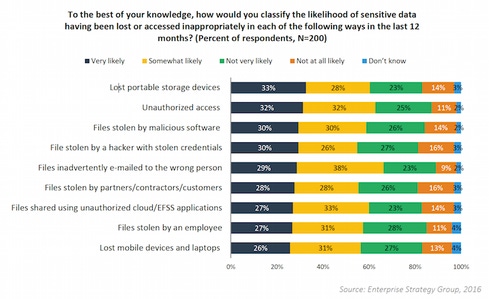Most organizations believe they have lost sensitive information due to external file sharing and third-party collaboration.

The common business practice of collaboration with partners, customers, contractors, and other third parties is driving concerns about sensitive data loss, new studies show.
Nearly 35% of organizations say 26% to 50% of their employees regularly share files with audiences outside the organization, which has increased concern about losing sensitive corporate data, according to an Enterprise Strategy Group (ESG) report. Nearly all (98%) of survey participants report that sensitive data loss is a top or significant concern, and many claim it is likely their business has already lost data via several routes in the last 12 months.
The study, which was commissioned by Seclore, surveyed 200 IT and cybersecurity professionals responsible for planning, implementing, or operating their organization's infosec policies and safeguards. The goal was to measure challenges and best practices for secure data transfer among internal and external audiences.
Respondents explained their corporate use of enterprise file sync and share (EFSS), FTP and email, data security control usage, and need for enterprise digital rights management (EDRM).
"The research conducted by ESG reveals that a majority of participating organizations feel it is very or somewhat likely that sensitive data has been lost or accessed inappropriately via a variety of ways including those that entail external collaboration," writes ESG senior analyst and report author Doug Cahill.
There are several means through which companies lose sensitive data, Cahill explains. Information can be accidentally shared via lost portable storage devices, stolen credentials, malicious software, unauthorized access to data, theft by partners or customers, inadvertent emails to the wrong people, or unauthorized cloud/EFSS apps.
Research indicates sensitive data loss is not limited to hackers. Twenty-seven percent of respondents said it is "very likely" an employee has stolen sensitive data in the last year, and 28% said the same about third parties.
Seclore CEO Vishal Gupta explains the various ways companies share sensitive data and how this can be dangerous. HR information is often shared with external payroll processors; financial data is shared with board members and third-party advisors; tech specs and drawings are shared with contracted engineers.
"There are dozens of stories where an engineer shared [intellectual property] with a competitor or took it to start their own company," he cautions. "The loss in revenue and market share is a huge business risk."
Concerns about protecting sensitive corporate information have slowed the adoption of cloud and BYOD technologies, Cahill says. The combination of cloud apps and mobility expands the surface area for potential attacks and increases the risk of data loss.
"The efficiencies and agility provided by the cloud and mobility make the associated workstreams the new normal of business operations, and thus necessitates data security solutions which create a data perimeter with a frictionless end-user experience," he explains.
To protect their data, businesses need the type of security technologies that automatically secure the "five W's" of data control: who can access which files, what they can do with the files, from which location or device, and when.
The findings from ESG align closely with similar research from Intel McAfee Labs, which aimed to measure data loss trends. Intel commissioned the study to learn more about data theft, types of data being stolen, and how data exits organizations.
The number of data loss incidents varies depending on the size of an organization. Small businesses (1,000-3,000 employees) report a median of 11-20 incidents per day. Midsize companies (3,001-5,000 employees) report a median of 21-30 per day, and large companies (5,000+ employees) report a median of 31-50 data loss incidents daily.
It seems many businesses are not taking the right precautions to protect their data. Researchers discovered that only 37% of businesses monitor physical media like thumb drives, even though these devices contribute almost 40% of data loss occurrences.
Nearly 60% of respondents have launched cloud-based apps and nearly 90% claim to have implemented a type of protection strategy for cloud storage or processing. However, only 12% have created visibility into data activity in the cloud.
The Intel McAfee research also discovered more than a quarter of companies don't monitor the sharing of, or access to, sensitive employee or customer information. Only 37% of small- to medium-sized businesses monitor the use of both; this rises to half for large businesses.
This needs to change, as the gap between data loss and breach discovery is growing. What's more, the most commonly used forms of data loss prevention are becoming less effective against new targets of theft. Unstructured data types are harder to monitor than structured data, and companies relying on default data loss prevention may think their safeguards are stronger than they are.
About the Author(s)
You May Also Like
Beyond Spam Filters and Firewalls: Preventing Business Email Compromises in the Modern Enterprise
April 30, 2024Key Findings from the State of AppSec Report 2024
May 7, 2024Is AI Identifying Threats to Your Network?
May 14, 2024Where and Why Threat Intelligence Makes Sense for Your Enterprise Security Strategy
May 15, 2024Safeguarding Political Campaigns: Defending Against Mass Phishing Attacks
May 16, 2024
Black Hat USA - August 3-8 - Learn More
August 3, 2024Cybersecurity's Hottest New Technologies: What You Need To Know
March 21, 2024




